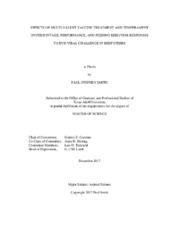| dc.description.abstract | The objectives of this study were to examine the effects of vaccine treatment (VT) and temperament on DMI, performance, and feeding behavior responses to a BVD viral challenge. Nellore-Angus crossbred steers (N =360; initial BW 330 ± 48 kg) were assigned to 1 of 3 vaccine treatments: non-vaccinated (NON), modified live (MLV), and killed (KV). Performance, DMI, and feeding behavior traits were monitored for 56 d during 4 14-d periods, using a GrowSafe® system. All steers were inoculated intranasally with a BVDV type 1b at the end of the first 14-d period. Exit velocity (EV) was measured on days 0 and 14 and the average was used to compute initial relative exit velocity (REV), which was used to examine the effects of temperament. As expected, DMI, ADG, G:F, and frequency and duration of feeding events all decreased (P < 0.01) during period 2 following BVD viral challenge and subsequently increased during period 3. Average daily gain and G:F were not affected by vaccine treatment or the VT x period. However, the reduction in DMI following BVD viral challenge was less (P < 0.05) for MLV-vaccinated steers compared to KV- and NON-vaccinated steers.
There were no VT x period interactions for any of the feeding behavior responses. Vaccine treatment clearly altered feeding behavior responses, such that MLV-vaccinated steers had greater (P < 0.01) duration of feeding events, meal frequency, and slower (P < 0.01) eating rates compared to KV- and NON-vaccinated steers. In general, calm steers (initial REV – 1 SD) had lower DMI, ADG, and G:F compared to excitable steers (initial REV + 1 SD). Temperament affected feeding behavior responses such that, calm steers had greater feeding duration and slower eating rates compared to excitable steers. With the exception of meal frequency, VT x initial REV interactions indicate there were greater differences between vaccine treatments within calm steers compared to excitable steers. Overall the results of the current study suggest that the MLV vaccine mitigated the negatives effects of the BVD vial challenge to a greater extent than the KV vaccine, which corresponds with previous findings regarding immune responses. | en |


